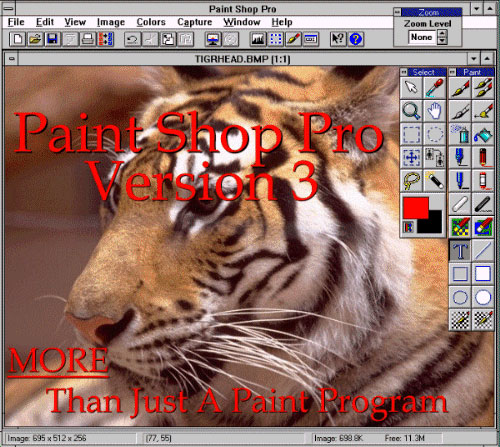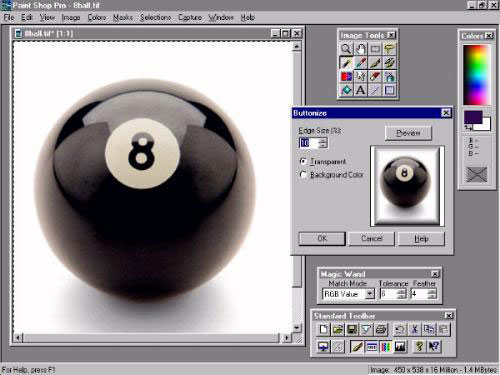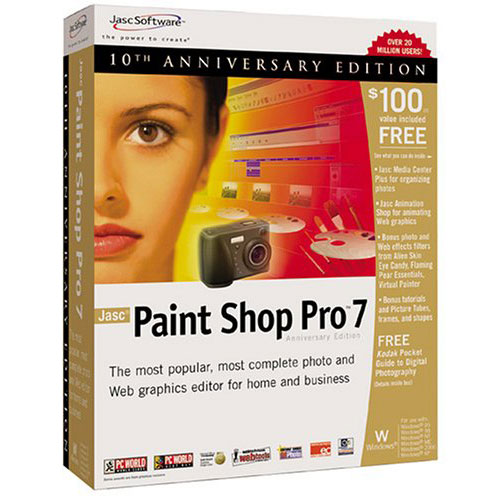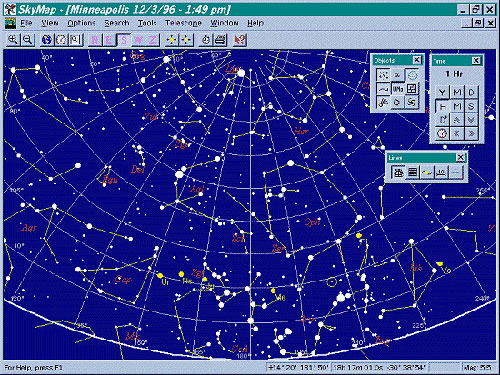Painting Outside The Lines
Adobe was already a big company when it first sold Photoshop, but its biggest competitor, Paint Shop Pro, was built by an airline pilot in his free time.
Hey all, Ernie here with a refresh of a classic Tedium issue. (Lotta busted backlinks in this one that are now fixed.) This is a fascinating tale of shareware being the great equalizer. Read on!
Speaking of useful software by independent developers made available for cheap, be sure to give today’s sponsor, SetApp, a look:
Looking for a little help in figuring out your approach to productivity? If you’re a Mac user, be sure to give Setapp a try. The service makes available hundreds of apps that can help you get more focused, simplify complex processes, even save a little time—all for one low monthly cost. Learn more at the link.
$69
The list price for Paint Shop Pro version 3.12, the first version to support both Windows 3.1 and Windows 95. The software was noteworthy at the time for including many, though not all, of the features of Adobe Photoshop 3.0, a program that sold for $895 upon its 1994 release.

Paint Shop Pro version 3 (via the JASC website, circa 1997)
The airline pilot that got Paint Shop Pro airborne
There were a handful of differences between Paint Shop Pro and Photoshop that meant something in the late ’90s—for example, Photoshop’s longtime killer feature, editable layers, didn’t hit Paint Shop Pro until 1998. And PSP was never a Mac endeavor, which somewhat limited its appeal in the professional design space.
But the biggest difference didn’t involve the features of the platform: It involved the people who made it. Adobe was already a large company in 1990 when it released the initial version of Photoshop, and it was on the stock market way back in 1986.
But Paint Shop Pro came from completely different roots. Initially, it was the work of a single developer, Robert Voit. (While Photoshop was initially developed by two university students, Thomas and John Knoll, the software had been acquired and polished by Adobe before it ever saw public release.)
A Minnesota-based pilot for Northwest Airlines with a degree in computer science, Voit was a heavy tinkerer with an interest in imagery. And when he got his hands on Microsoft Windows, he ran into a personal frustration that got him coding: GIF files were common ways of exchanging images on CompuServe (where they had been introduced in 1987) and other services, but they weren’t supported natively by Windows 3.0—meaning that there was no easy way to apply GIFs as wallpaper on Windows desktops.
Fortunately, Voit was ready with a solution. He created a converter called GIF2PCX, which allowed images to be saved in the Windows-friendly PCX format, which was supported by Microsoft Paint.
From that starting point, Voit moved toward building PaintShop, a $25 multi-format converter featured in PC Magazine in 1991. Soon, the software evolved into Paint Shop Pro.
In a 1999 interview with Inc. Magazine, Voit explained that his software, which he effectively made because he couldn’t find a graphics editor that did everything he wanted to do, was extremely inexpensive to make.
He kept his day job when he started JASC Software in 1991. (The name, which stands for “Jets and Software Company,” reflected this.) There wasn’t a massive business there at first, just a growing one, and the shareware distribution model kept costs down. All he needed to do to sell it was tell people where and how to pay, buy some stamps and envelopes, and create encryption codes that users could use to get rid of the nag screen. The bulletin boards, FTP sites, and tech-savvy users of the era handled the rest.
“I’d go flying, come home, and have a backlog of orders,” Voit explained.
He didn’t need a lot of employees, either. His first hire, who manned the phones and distributed the codes, came along in 1992. He needed the help: Despite this minimal scale, the software was getting rave reviews which ensured there’d be a lot of work. PC Magazine called Paint Shop Pro Version 1.01, which didn’t even allow for bit-level editing of images or support the JPEG format, “a bargain hunter’s dream” for its high functionality and $49 price.
“It lacks some of the bells and whistles of other graphics-conversion utilities, but it covers all the basics, does them fast and well, and provides most of the services you’ll find in programs costing three to five times as much,” Barry Simon wrote.

Paint Shop Pro version 4.0 for Windows 95.
Through smart pricing and smart distribution, Paint Shop Pro had found the perfect niche. Voit had invented “prosumer” software, highly functional tools that were accessible to home users.
And despite that tiny scale, PSP had millions of users.
“Every one of them is bigger than us. It just makes it more challenging. It actually keeps it fun in some ways. we’re the underdog.”
— Robert Voit, in a 1998 profile with his local newspaper, the St. Cloud Times. At this time, when JASC Software was beginning to sell copies of Paint Shop Pro in stores. In 1995, JASC had just six employees. By the time this article was published, the firm had 60, including his sister Kim, who claimed her brother had a Midas touch. “Whatever he touches turns to gold,” she said. (For comparison’s sake: According to Adobe’s 1998 annual report, it had 2,664 employees.)

Paint Shop Pro, in shrink-wrap form.
Paint Shop Pro was such a good program, it outgrew shareware
There are just a few pieces of shareware out there that pulled off what Paint Shop Pro did from a distribution standpoint.
id Software’s triple threat of Wolfenstein 3D, Doom, and Quake were so good that they each transcended their shareware status. Epic Megagames’ early titles like ZZT, Jazz Jackrabbit, and Epic Pinball set the stage for a company whose technology is fundamental to modern gaming. And late programmer Phil Katz’s freely distributed but controversial PKZIP spawned a large company that outlived its founder.
Robert Voit had one of those apps, and he ended up quitting his job in 1995 to support it.
“We just broken $1 million in the previous month. The growth rate of the company was phenomenal,” Voit told the St. Cloud Times in 1995. “Everything indicated the company would be prosperous, especially if I spent more time with it.”
But what Robert Voit did was most impressive, because once he quit his job and reached scale, he decided to rip off the band-aid and turn his back on the model that made his company.
That’s right: JASC put a time limit on Paint Shop Pro and started competing with Adobe and other companies using the kind of shrink-wrapped packaging techniques bigger firms were using. The reason? Per Inc., Voit felt the app had plateaued from a sales standpoint.

A screenshot of SkyMap, another program JASC sold in the ’90s.
So JASC turned Paint Shop into just another product you can buy at Best Buy. But it also greatly expanded its ambitions—something highlighted by the growth in its headcount. The company was selling a wide variety of apps by 1997, mostly graphics-related, but also including some intriguing entries like SkyMap, a digital “planetarium” program, and Ornamatica, a program designed to make it easy to create borders.
These were apps created by outside developers, but JASC took advantage of the attention it was getting to give them distribution.
Paint Shop Pro was still very much the breadwinner—the subject of books, just like the big players—and the app’s features just kept getting better. But JASC eventually passed the baton to someone else.
“If you look at the Paint Shop product today, it’s already a pretty solid contender against Photoshop. If we add in functionality from CorelDraw and other products, that’s going to make it even more compelling.”
— Amish Mehta, then the CEO of Corel, discussing the firm’s 2004 acquisition of JASC Software with ZDNet. (The price was undisclosed.) It was one of many acquisitions Corel has made over the years, fitting the company’s recent reputation for being the Island of Misfit Software, due to its tendency to acquire and nurture mature apps. Beyond Paint Shop Pro and its own internally developed software, the firm has also acquired WordPerfect, WinZip, Roxio, and AfterShot, among others. That said, Paint Shop Pro is probably the app that best fits with its most popular homemade offerings, CorelDraw and Painter.
These days, Paint Shop Pro survives, if far from the hands of the Minnesota man who first created the platform.
The story of the software’s creation is quietly legendary, but it’s in the past. Despite initially pledging to keep the office open, Corel closed the Eden Prairie, Minnesota office that was once home to JASC more than a decade ago, with a focus on outsourcing and a doubling down on Silicon Valley. (Corel had a rocky few years.)
The modern app, even though it’s maintained by developers that had nothing to do with its creation or early development, still gets good reviews from PC Magazine all these years later.
“Photoshop is a magnificent tool, but truth be told, many of its users could do everything they need in Corel’s photo editing software, PaintShop Pro, without having to pay monthly tribute to Adobe,” the magazine’s Michael Muchmore wrote in his review of Corel Paintshop Pro 2020.
/uploads/Paintshop-Pro-2020-Boxes.png)
Oddly, though, the model has flipped in a way. While still charging high prices, Adobe has taken its software to the cloud, with distribution driven by downloads. Paint Shop Pro, on the other hand, is the one that sells in the shrink-wrapped box.
In some ways, Robert Voit’s legacy appears less in the product that evolved from his code than in the weekend developer ethos he inspired, one that appears in the App Store and on sites like Product Hunt.
And as Voit put it in 1998: “It’s fun to do battle with them in corporate America and still come out on top when you’re the littlest guy.”
Corel isn’t the little guy, but there are a lot more smaller players now than there were in 1992—and plenty of ’em are coming out on top.
--
Find this one an interesting read? Share it with a pal! And thanks again to SetApp for giving us a push.
:format(jpeg)/2017/02/tedium020917.gif)
/2017/02/tedium020917.gif)


/uploads/ernie_crop.jpg)